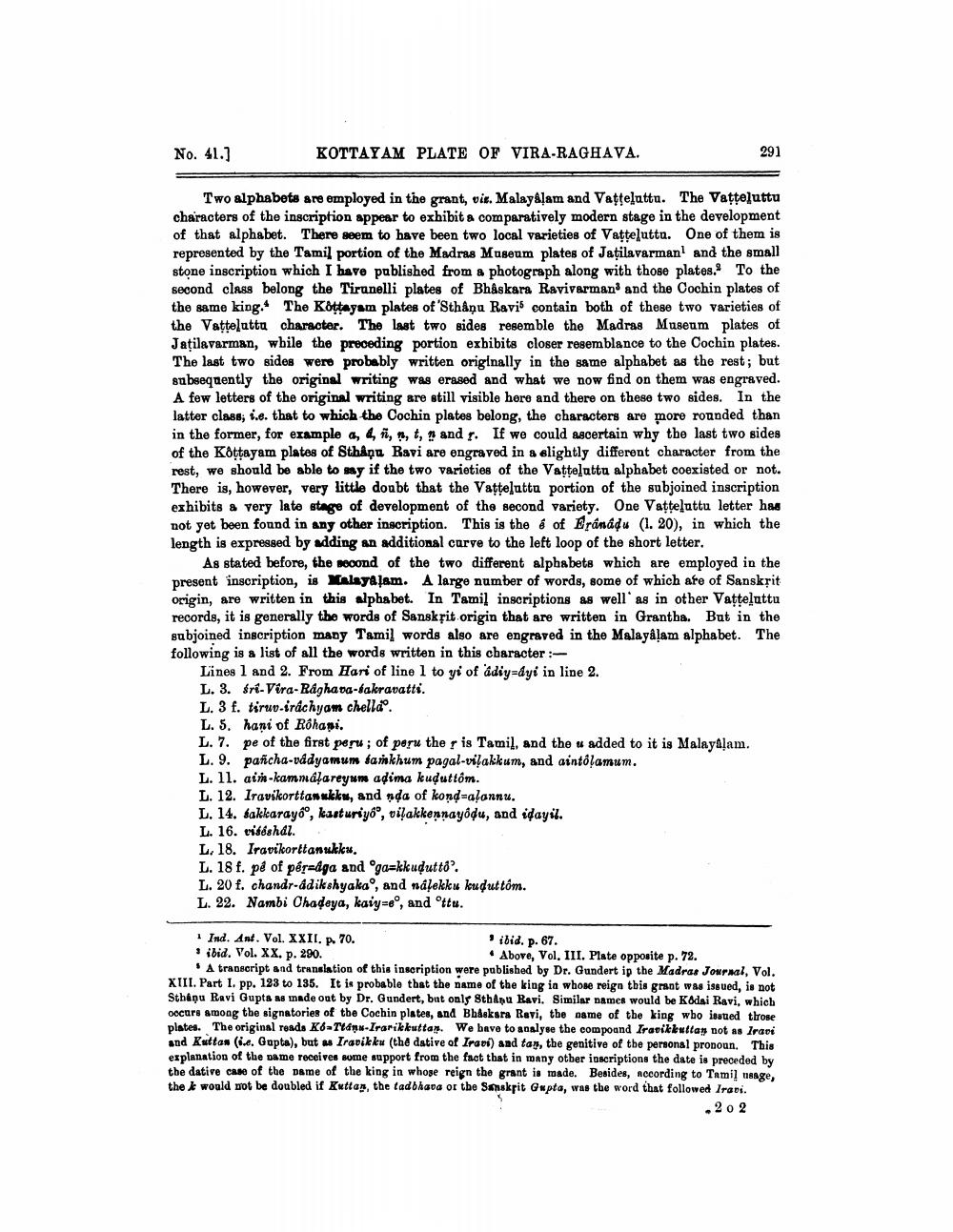________________
No. 41.]
KOTTAYAM PLATE OF VIRA-RAGHAVA.
291
Two alphabets are employed in the grant, vit. Malayalam and Vattelutta. The Vatteluttu characters of the inscription appear to exhibit a comparatively modern stage in the development of that alphabet. There seem to have been two local varieties of Vattelutta. One of them is represented by the Tamil portion of the Madras Museum plates of Jaţilavarman and the small stone inscription which I have published from a photograph along with those plates. To the second class belong the Tirunelli plates of Bhaskara Ravivarmand and the Cochin plates of the same king. The Kottayam plates of 'Sthåņu Ravis contain both of these two varieties of the Vattelutta character. The last two sides resemble the Madras Museum plates of Jatilavarman, while the preceding portion exbibits closer resemblance to the Cochin plates. The last two sides were probably written originally in the same alphabet as the rest; but subsequently the original writing was erased and what we now find on them was engraved. A few letters of the original writing are still visible here and there on these two sides. In the latter class, s.e. that to which the Cochin plates belong, the characters are more rounded than in the former, for example a, 4 , , , ? and r. If we could ascertain why the last two sides of the Kottayam plates of Sthåņu Ravi are engraved in a slightly different character from the rest, we should be able to say if the two varieties of the Vattelatta alphabet coexisted or not. There is, however, very little doubt that the Vattelutta portion of the subjoined inscription exhibits a very late stage of development of the second variety. One Vatteluttu letter has not yet been found in any other inscription. This is the é of Erânadu (1. 20), in which the length is expressed by adding an additional carve to the left loop of the short letter,
As stated before, the second of the two different alphabets which are employed in the present inscription, is Malayalam. A large number of words, some of which are of Sanskrit Origin, are written in this alphabet. In Tamil inscriptions as well as in other Vatteluttu records, it is generally the words of Sanskrit origin that are written in Grantha. But in the subjoined inscription many Tamil words also are engraved in the Malayalam alphabet. The following is a list of all the words written in this character :
Lines 1 and 2. From Hari of line 1 to yi of 'adiy=dyi in line 2. L. 3. fri-Vira-Raghana-hakravatti. L. 3 f. töruv-sráchyam chelldo. L. 5. hani of Róhapi. L. 7. pe of the first peru; of peru the is Tamil, and the w added to it is Malayalam. L. 9. pañcha-vadyamum samkhum pagal-vilakkum, and aintolamum. L. 11. air-kammálareyum adima kuduttom. L. 12. Iravikorttanukku, and nda of kond-alannu. L. 14. bakkarayo, kasturiyő, viļakkennayodu, and idayil. L. 16. vidéshdi. L. 18. Iravikorttanukku. L. 18 f. på of pér=dga and ga=kkudutto. L. 20 f. chandr-adikshyaka', and nålekku kuduttôm. L. 22. Nambi Chadeya, kaiy=e", and "ttu.
· Ind. Ant. Vol. XXII. p. 70.
ibid. p. 67. ibid. Vol. XX. p. 290.
• Above, Vol. III. Plate opposite p. 72. A transcript and translation of this inscription were published by Dr. Gundert ip the Madras Journal, Vol. XIII. Part 1. pp. 123 to 135. It is probable that the name of the king ia whose reign this groot was issued, is not Sthanu Ravi Gupta is made out by Dr. Gundert, but onls Sthanu Ravi. Similar names would be Kodai Ravi, which occurs among the signatories of the Cochin plates, and Bhaskara Ravi, the name of the king who isuued throse plates. The original reads K-Trans-Irarikkuttam. We have to analyse the compound Iravitbultay not as Iravi and Kuttan (i.. Gapta), but as Iravikku (the dative of Iravi) and tay, the genitive of the personal pronoun. This explanation of the same receives some support from the fact that in many other inscriptions the date is preceded by the dative case of the name of the king in whose reign the grant is made. Besides, according to Tamil mage, the k would not be doubled if Kutta, the tadbhava or the Sanskrit Gupta, was the word that followed Iravi.
2 0 2




